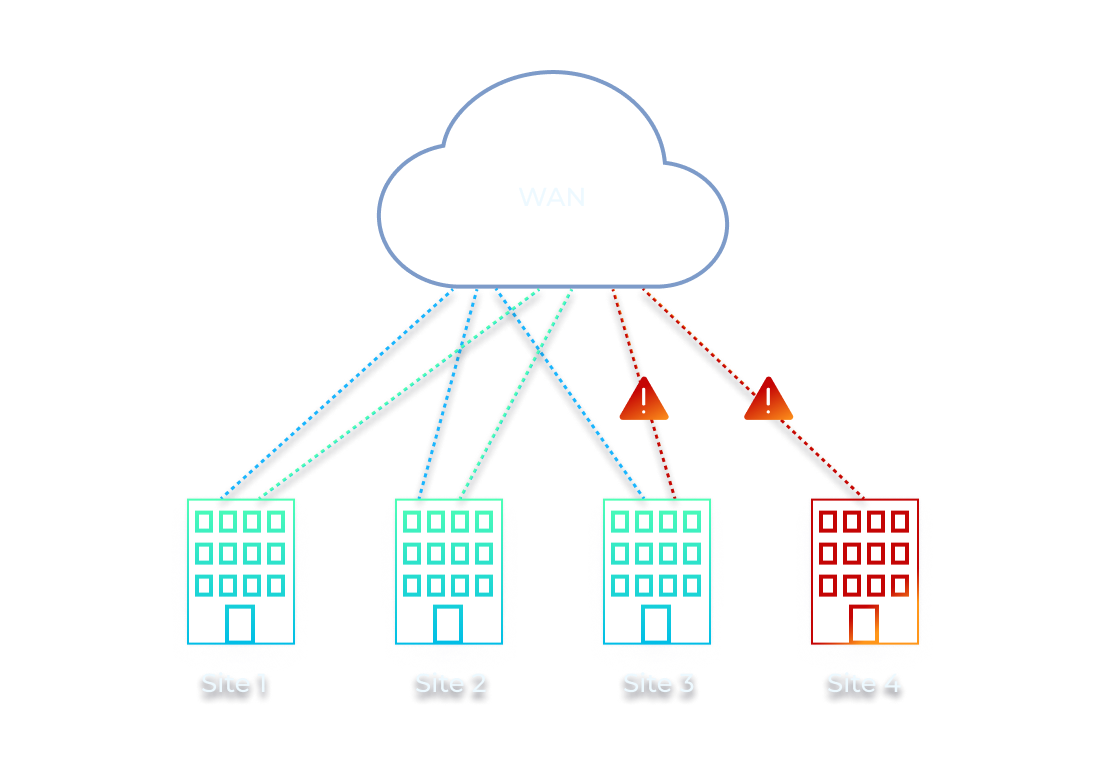Competitiveness in the modern workplace means having a strong connection anytime, any place. Your business will thrive and scale with WAN fault tolerance and an uptime guarantee.
What Is a WAN?
WANs (Wide Area Networks) is a logical grouping of geographically dispersed, interconnected networks and their devices within them. Built on the incredibly vast infrastructure of telecommunications and data communications providers throughout the globe, WANs are the largest and most extensive forms of computer networks.
WANs can be categorized as Public Networks and Private Networks. The internet, or clear web, is the largest WAN in existence and all addresses are essentially able to route to one another.
Private Networks, on the other hand, consist of networks belonging to a business or organization where addresses are only routable within it. Most businesses today leverage both public and private WANs to operate.
What is WAN Fault Tolerance?
WAN Fault Tolerance is the ability of a given WAN to continue operating without interruption during the failure of one or more components. We measure WAN Fault Tolerance in a given network uptime availability– generally measured as a percentage of time within a calendar year that it is able to both send and receive traffic. This is where you’ll see service availability values such as 99%, 99.99%, and 99.99999%, etc.
The gold standard of WAN uptime objectives in the early 2000s was to meet or exceed 99%; or incur less than 4 days of downtime per year- that would include the network edge (routers, gateways, firewalls), ‘last mile transit or transport connectivity, carrier networks, and peering interconnections.
Times have changed, and, as they say, “time is money” and now business uptime objectives are looking to approach 100%. Businesses are doing this by making use of highly available and redundant WAN components, such as HA routers and multiple diverse connections on unique paths from different telecommunications providers.
Building fault tolerance into your business’ WAN will not only add to your capacity and scalability but also eliminate single points of failure and prevent costly downtime and losses in productivity.

How Does Fault Tolerance Work?
Fault tolerance removes the risk of a single point of failure disrupting any given site on a WAN’s ability to send or receive traffic. To work effectively, the system must not rely on one single component (router, circuit, telecom provider, etc.) Without fault tolerance, a site will go down in the event of any single component interruption, degradation, or failure. Fault tolerance requires architectural planning: from a high availability design of the edge, Software Defined WAN (SDWAN) routing over multiple carrier connections and diverse path connections from different telecommunications providers.
Why Connectivity Anywhere and WAN Fault Tolerance Matters
All modern businesses rely on internet WAN connectivity to utilize cloud and SaaS services, as well as Private WAN access to connect to private applications hosted by the organization. Depending on the size and financial metrics of your business, a single hour of downtime will cost you thousands, or potentially millions of dollars.
However, with our fault-tolerant architected WAN solutions, we can connect all of your locations, anywhere in the globe, with fast, resilient connectivity, architected to any uptime objective or budget!

Connectivity Options
Keeping your business connected without interruptions or downtime is critical for daily operations. Whether you’re a startup, small business, or global enterprise, Defensive can help you design a WAN to fit your uptime objectives, throughput requirements, and budget.
Speed and Uptime are key to your business’s ability to innovate, collaborate, and forge stronger relationships with your customers. With the rapid migration to the cloud, exceptional connectivity is more important than overall. So, what are your options?
FTTX
Fiber Broadband, known as FTTX or Fiber to the X (Where X is Building, Premise, Home, etc.), is the next generation of broadband technology utilizing modernized optical networking.
FTTX connections provide faster, often symmetrical, and lower latency connectivity to businesses and homes than their standard broadband predecessors. Since providers are leveraging shared infrastructure and economies of scale, FTTX services are very cost-effective for the speeds they deliver. While FTTX growth has exploded over the years, it is still generally only available from select carriers in densely populated areas.
Dedicated Fiber Internet Access
Dedicated Fiber Internet Access services- the name says it all. This is a fiber internet connection dedicated to your business. Telecommunications providers will guarantee upload speeds, download speeds, uptime service levels, low latency, and low packet loss. While many business report slowdowns in broadband services during peak usage times, dedicated internet access delivers consistent speeds that your business can count on.
Dedicated Fiber Internet Access is the best option for businesses with medium and/or large offices, or small offices with staff that require enhanced speed and uptime to be productive.
Dark Fiber Leases and Indefeasible Right of Usage (IRU)
With the exclusive, unrestricted, and indefeasible right to use fiber cables for your business, you connect your locations at any speed that your optics can pulse. Dark fiber networks provide reliable and secure infrastructure to self-manage elements of your network.
Dark fiber provides your business with optimum flexibility and control to support, theoretically, unlimited bandwidth whenever and wherever you need it.
Extensive Coverage
With extensive wide-area network coverage and fault tolerance across six continents, you can connect wherever you are at any time. Whether you need a far-reaching connection or a highly-secure network, our solutions are customized to meet the needs of your business and scale with you.
Featured Connectivity Anywhere & WAN Fault Tolerance Partners
Factors To Consider in WAN Fault Tolerance
Cost
Architecting fault tolerance into your WAN might seem costly, but with regular cost compressions on bandwidth, and the affordability of technologies like SDWAN and FTTX, redundancy and fault tolerance has never been more affordable! On the contrary, with our face paced business world and the need for connectivity, our cost of slowness and interruption has never been higher.
Architecture and Performance
Businesses need to take into account speed, costs, uptime objectives, as well as network design when designing their next-generation WAN to meet the needs of the business today and in the future. We have the experience and expertise to design networks tailored to your exact needs and budgets.
Automation and Self Healing
We architect networks expecting component failure. Your network should be able to continually send and receive traffic during individual component failures and interruptions via redundancy. While we leverage these architectural principles to keep businesses running during interruptions, we leverage monitoring automation to automate the trouble ticketing process to resolve interruptions as quickly as possible.
Why Defensive Networks?
Defensive is a Next Generation Solution Provider for a Cloud-First World. We exist to take the guesswork out of Cybersecurity and Information Technology procurement and adoption.
Defensive of your Brand.
We are trusted by leading enterprises around the globe.
Defensive of your People.
Let’s create harmony between Infosec, IT, Executives, End Users, and Finance.
Defensive of your Time.
We’re straight to the point with technologies and strategies that work.
Defensive of your Budget.
Eliminate wasted expenditure and maximize the value of every dollar.
TRUSTED BY
87 of the Fortune 1000
Over 1,400+ small, medium and large enterprises.









As Seen In
How Can Defensive Help?
Our connectivity solutions and WAN fault tolerance approach guarantee a fast, secure, and reliable network to ensure optimal business performance. Speak to our team today to find the right product for your business operations.

Connectivity Anywhere, Fault Tolerance
Networks
Powered By DEFENSIVE











